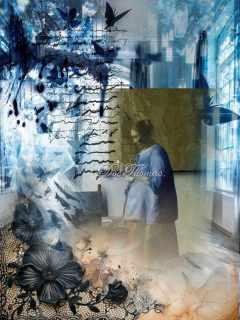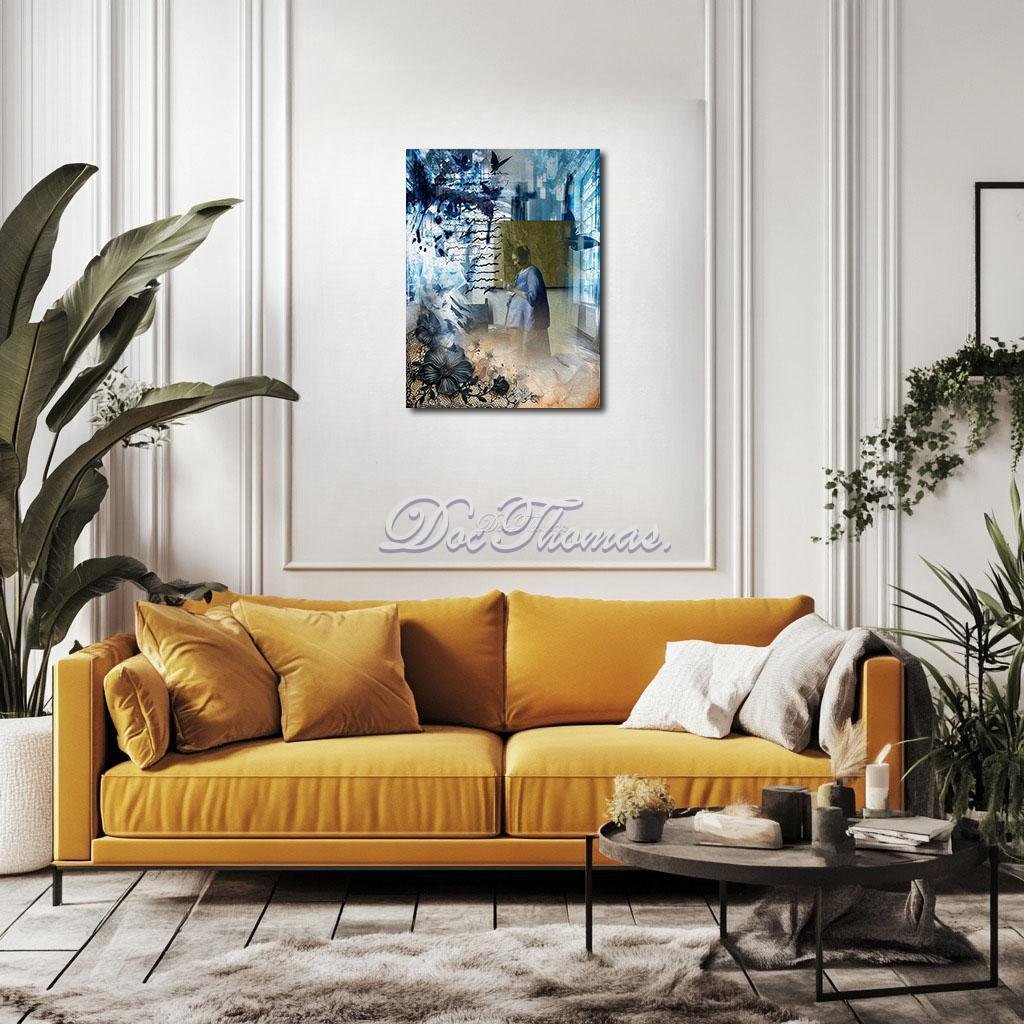Veins of Porcelain: The Ink That Drowned the Silence
Veins of Porcelain: The Ink That Drowned the Silence reinterprets Vermeer’s Woman Reading a Letter as a lyrical descent into memory and emotional disarray. The letter dissolves into unreadable ink, transforming into birds, butterflies, and bleeding script. The figure, still draped in Vermeer’s blue, now stands amid frostlight, gothic florals, and a spectral corridor of layered reflections. Ice blues, silvers, and inky blacks guide the emotional rhythm, evoking suspended sorrow and the deep breath between heartbreak and understanding. This work is a meditation on unreadable truths—the kind that arrive on paper, but finish their story inside the soul.
Please see Below for Details…
Hotline Order:
Mon - Fri: 07AM - 06PM
404-872-4663
Veins of Porcelain: The Ink That Drowned the Silence reimagines Johannes Vermeer’s Woman Reading a Letter as a spectral hymn to grief, intimacy, and the slow erosion of clarity in moments of silent revelation. The quiet introspection that once hovered in Vermeer’s sunlit interior has been displaced by a flood of melancholic ink, where language floats unmoored, and emotion is rendered in pigment, lace, and shadow. The woman remains a solitary figure in blue, yet now she is surrounded by a poetic storm—script that bleeds across the page, butterflies pinned midair, and ghostly flowers curling like forgotten margins in a letter never sent.
This reimagining fuses the structure of Vermeer’s precise domestic stillness with an atmospheric chaos. Her letter, which once offered silent narrative tension, has become the epicenter of surreal unraveling. Words scatter from it like birds startled into flight. They arc upward, caught in mid-sentence, illegible but felt, like the echoes of what one never dares to say aloud. Her blue gown—Vermeer’s original visual anchor—is now draped in shadow and frostlight, as if woven from regret and memory. Even the room’s perspective seems liquefied. The once-stable interior has dissolved into a spectral corridor of overlapping transparencies, evoking the feeling of standing within someone else’s memory.
The color palette speaks the language of emotional temperature. Ice blues and silvers dominate the upper registers, creating an atmosphere of suspended breath. These hues evoke the frozen moment before tears fall, the pause between heartbeat and ache. The woman's gown retains its original Delft blue tone, but it is now tinged with a silvery sheen, linking her to the dreamlike setting—part human, part apparition. At her feet, the floor and floral lace are rendered in inky blacks and sepias, blooming with gothic peonies and wilting petals. These deep shadows are not merely decorative but represent decay—emotional residue, unspoken endings, the mortality of love. Warmth is limited to the edges: a pale rose-brown blush at the bottom left, reminiscent of dried ink or pressed skin. The letter glows with a ghostly white, standing out not for its lightness, but for the absence it signifies—a letter more void than voice.
As the artist, my thought while reimagining Woman Reading a Letter was to explore how communication breaks down when overwhelmed by feeling. In Vermeer’s time, letters were vessels of intimacy and delay. They delivered news across distances both physical and emotional. I imagined the moment just after a woman finishes reading such a letter—the moment of total silence when her world reorganizes. That silence, to me, is loud. It ripples out like ink spilled on water, bleeding meaning into everything. I did not want to show the content of the letter. Instead, I wanted to show what it did —how it filled the air, stained the room, curled the flowers, and caught even the light off guard.
I surrounded her with symbols of suspended transformation. Butterflies frozen in place, their wings tracing patterns in the margins of language, suggest a metamorphosis never completed. They are fragile, like the truths we often keep from ourselves. The black flowers curling at the base evoke mourning, not just for someone lost, but for versions of ourselves that are no longer reachable. Even the window to the left—Vermeer’s traditional portal to light and hope—is here glazed in icy blue, barely visible, more like a memory than a source of illumination.
The ink that bleeds across the composition is not chaotic—it is choreographed. Each drip, curve, and slash has rhythm, like a lament written in calligraphy. The lines do not sit on the surface; they interact with the woman’s breath, her pulse, her silence. In this reimagination, the letter she reads is not just paper—it is a portal. And what emerges is not a message, but a reckoning. A woman absorbing not just words, but the weight of what they cannot contain.
Veins of Porcelain: The Ink That Drowned the Silence is a painting about rupture disguised as quietude. It honors Vermeer’s mastery of subtlety while expanding that subtlety into a cascade of poetic distortion. It is a tribute to what letters leave behind—the residue of longing, the hunger for clarity, the ache of timing missed. It is not a painting of a woman reading a letter. It is a painting of everything that letter set loose.
Add your review
Your email address will not be published. Required fields are marked *
Please login to write review!
Looks like there are no reviews yet.










